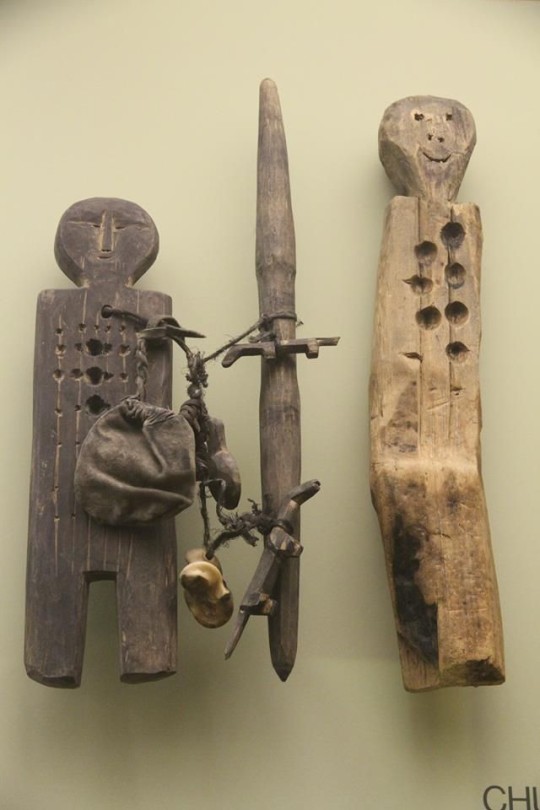#siberian shamanism
Explore tagged Tumblr posts
Text

SUCCUBUS SPIRIT WIVES OF THE YAKUT SHAMAN; Like many of the indigenous peoples of Siberia, the Yakuts practiced shamanism, who originally lived around the Olkhon and the region of Lake Baikal.
37 notes
·
View notes
Text
Interacting With Souls and Ghosts in Shamanism: Shaman as Psychopomp
The duties of a shaman involve existence in the borderline states. They also imply crossing the boundaries of the worlds and interacting with the inhabitants of various layers of the universe: shaman both welcomes a new soul that has come into the human world, and accompanies the deceased to the Kingdom of the Dead.

View On WordPress
#anthropology#Buryat shamanism#ethnography#Mongolian shamanism#ongon#shaman drum#shamanic beliefs#shamanic journey#shamanic practices#shamanic rituals#shamanic visions#Siberian shamanism#spiritual practice#shamanism#shaman#shamanic practice#shamanic healing#folklore#folklore studies#nature worship#spiritualguidance#spiritual journey#spiritual practices#mysticism
8 notes
·
View notes
Text
Mummified Shaman Discovered in Siberia

An almost perfectly preserved shaman burial site dating back to the 18th century has been discovered in remote Siberia. In only the second-ever archaeological study in the Yakutia area of Siberia, Russian researchers at the Institute for Humanitarian Research and North Indigenous Peoples Problems discovered the mummified remains of a fully-clothed man inside a sarcophagus.
Shamans are spiritual leaders among the Yakut, practicing as healers and diviners in their communities. Yakutia, the Yakut homeland, is hugely remote, situated in the far northeast of what is now Russia. When Russia occupied Yakutia in the 17th century, Orthodox Christianity began to influence the folk religion. However, during Soviet rule, shamans and their followers were persecuted. The religion didn't die out, though, and continued to be practiced in secret.
The burial lay at a depth of around 2.5 feet, and the sarcophagus was made of wide planks and covered with birch bark. The mummified body of a man was wearing a suit consisting of a caftan, a silk shirt, cuffs and legs. The shaman's legs were of particular interest, as they were covered with fabric that was embroidered with colored threads and a patchwork of leathers from hips to ankles. The shaman also wore a pair of leggings, a caftan, a belt, and was accompanied by a saddle, girth straps with iron buckles, stirrups, two bags and a funeral feast.
The shaman and its burial site are in remarkably good condition considering it has been buried for over 200 years. This is a truly unique find, because due to climate change, the preservation of items from archaeological excavations is getting worse every year, and the search for funerary monuments is gradually becoming more difficult due to dynamic changes in the landscape.
6 notes
·
View notes
Text










#indigenous rights#indigenous people#indigenous#native siberia#siberian indigenous#indigenous siberian#siberian#Gender#androgynous#culture#indigenous russia#indigenous russian#important#fypシ#fypage#russia#colonization#landback#land back#shaman#Shamanism
17 notes
·
View notes
Text

A Tatar shaman, Minusinsk, Siberia, c. 1910.
#Tartar#Shaman#Slavic#Slavic shaman#Slavic mysticism#Minusinsk#Siberia#Minusinsk Siberia#Siberian Shaman
55 notes
·
View notes
Text

3 notes
·
View notes
Text
fuck it it's fallout vipers but they're inspired by northeast asia shamanism time
#fallout#fallout new vegas#fallout van buren#fallout vipers#perso#man i can't stop headcanoning the people who founded vipers were originally immigrants from northeastern eurasia#like for some reason i don't see vipers as native american shamans... more like yakut/mongolian shamans#they kinda have that bit of tengrism vibe yk#ngl while i was putting together this playlist i couldn't help but think about my tatar father.. he was so obsessed with siberian shamanism#probably got it from my grandma lol
4 notes
·
View notes
Text


#artists on tumblr#artwork#my art#spooky#shamanic#baseball#mental health#healing#trauma#shamanism#shamanic art#traditional art#Siberian
0 notes
Photo

A shaman watches TV inside the Tos Deer ( nine skies) association in the Siberian town of Kyzyl, Republic of Tuva, Russia. Photographed by A. Abbas.
#photojournalism#siberia#photojornalist#shamanism#asia#tuva#russia#tuvans#a. abbas#northern asia#abbas
4K notes
·
View notes
Note
If you ever feel like it I’m gonna suggest a fly agaric mushroom themed faun because there’s some cool relation between fly agarics, reindeer, and Siberian shamans.

Day 27: a comfy little mushroom dude
210 notes
·
View notes
Text
Shamanism: Beliefs And Practice
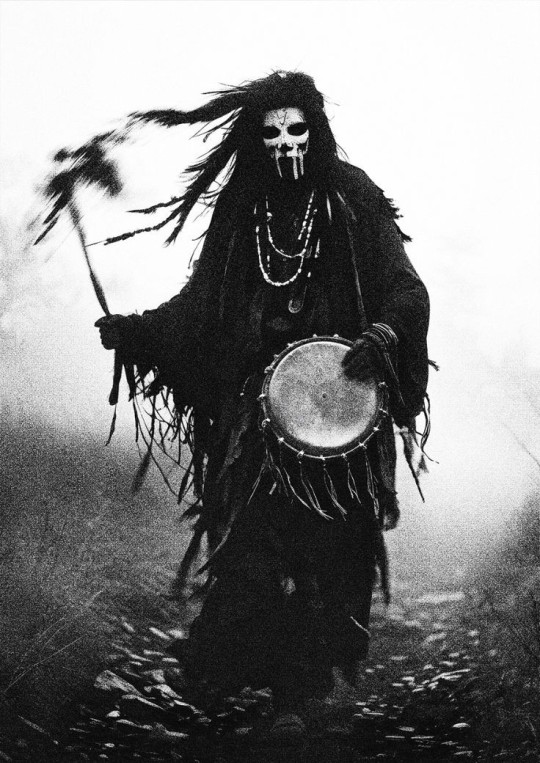
Shamanism is an ancient spiritual practice that involves a practitioner, known as a shaman, interacting with the spirit world through altered states of consciousness, such as trance. The goal is to direct spiritual energies for healing, divination, or other purposes.
Commonly Held Shamanic Beliefs
• Animism (the belief that all things, both animate and inanimate, possess a spirit or soul).
• Everything is interconnected.
• There is an alternate reality happening concurrently, often called the spirit world.
• Shamans can enter the spirit world freely, with intention.
• Spiritual journeys are an often necessary part of life.
• The spirit world can be a very real, very dangerous place.
• We are not alone, we have spirit helpers, familiars, ancestors, power animals, our guides.
• Energy has a unique footprint and vital force.
• It is possible to do work while in the spiritual realm that will have a direct effect on "ordinary reality"
The Practice of Shamanism
Shamanism is a diverse and ancient practice with a long history across various cultures worldwide. While it shares common themes, the specific practices and beliefs can vary significantly between different regions and traditions. Here's a breakdown of some key similarities and differences:
Core Practices:
• Spirit Communication: Shamans in all traditions believe in the existence of spirits and the ability to communicate with them. This communication can involve various methods, including trance states, drumming, chanting, and the use of sacred objects.
• Healing: Shamans often play a vital role as healers, using their connection to the spirit world to diagnose and treat illnesses. This can involve removing negative energy, retrieving lost soul parts, or negotiating with spirits causing harm.
• Divination: Many shamans possess the ability to predict the future, interpret dreams, and provide guidance through divination techniques like reading bones, stones, or other natural objects.
• Soul Retrieval: This practice involves journeying to the spirit world to retrieve parts of a person's soul that may have been lost due to trauma or other experiences.

Regional Variations:
• Siberian Shamanism: This tradition is characterized by its use of drums, costumes, and trance states to journey to the upper and lower worlds. Siberian shamans often work with animal spirits as guides and helpers.
• Central Asian Shamanism: Central Asian shamans, such as those found in Mongolia and Tibet, often incorporate elements of Buddhism and other religious traditions. They may use techniques like visualization and meditation to connect with the spirit world.
• Indigenous American Shamanism: Shamanic practices among Indigenous American cultures are incredibly diverse, but they often involve the use of sacred plants, sweat lodges, and drumming. Some traditions emphasize the importance of dreams and visions as a means of spiritual communication.
• Neo-Shamanism: This contemporary movement draws inspiration from traditional shamanic practices but adapts them to modern Western culture. Neo-shamans may use techniques like drumming, meditation, and plant medicine to induce altered states of consciousness and connect with the spirit world.
Key Differences:
• Spirit Guides: The types of spirits shamans work with can vary widely. Some may focus on ancestral spirits, while others may work with nature spirits, animal spirits, or deities.
• Rituals and Ceremonies: Different cultures have unique rituals and ceremonies associated with shamanic practice. These can range from simple personal rituals to elaborate community events.
• Training and Initiation: The process of becoming a shaman can vary significantly. Some traditions involve formal apprenticeships, while others rely on personal experiences and spiritual quests.
It's important to note that shamanism is a living tradition that continues to evolve. As cultures change and adapt, so too do shamanic practices. While there are many differences between various forms of shamanism, the core principles of connecting with the spirit world, healing, and divination remain central to this ancient and powerful tradition.

#shaman#shamanism#shamanic#spirit work#healing#magick#witch#witchcraft#witchblr#witch community#pagan#eclectic
156 notes
·
View notes
Text

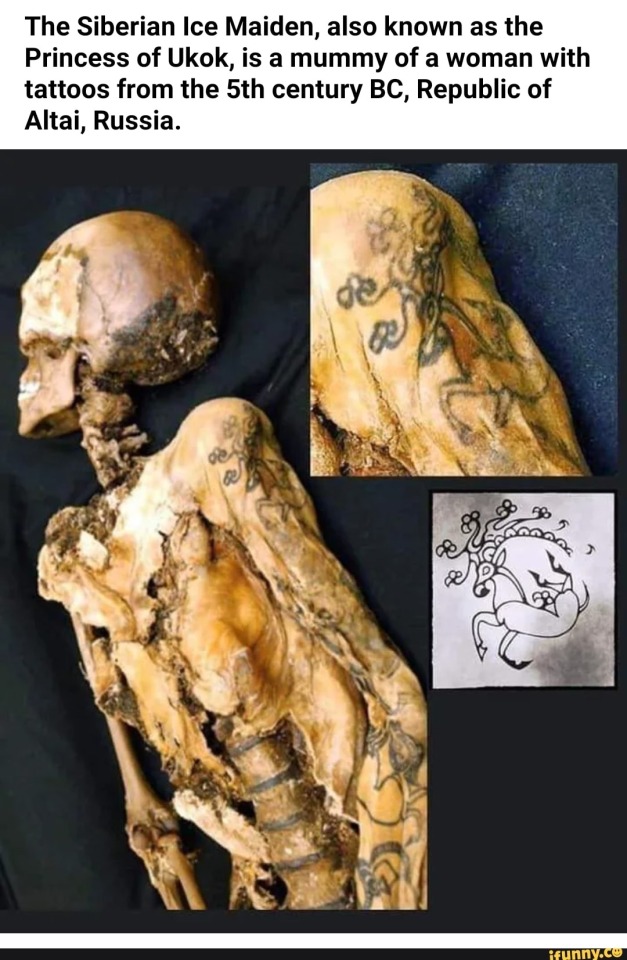
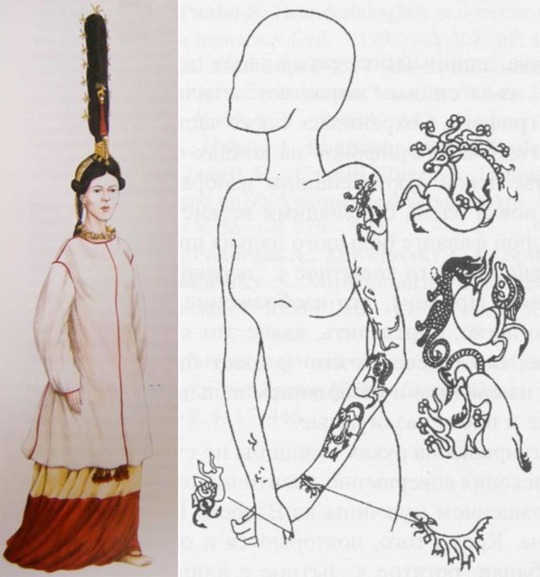

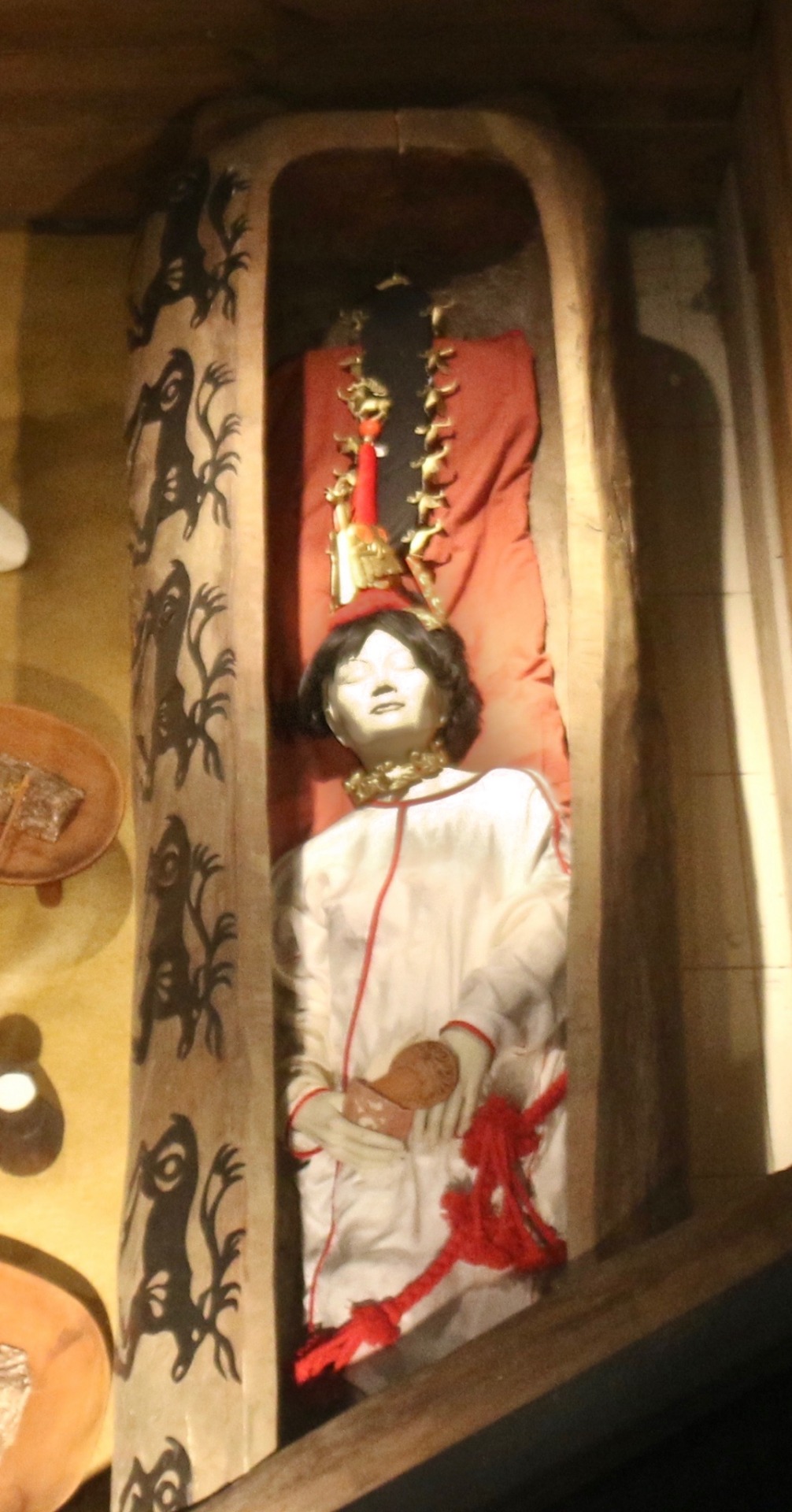
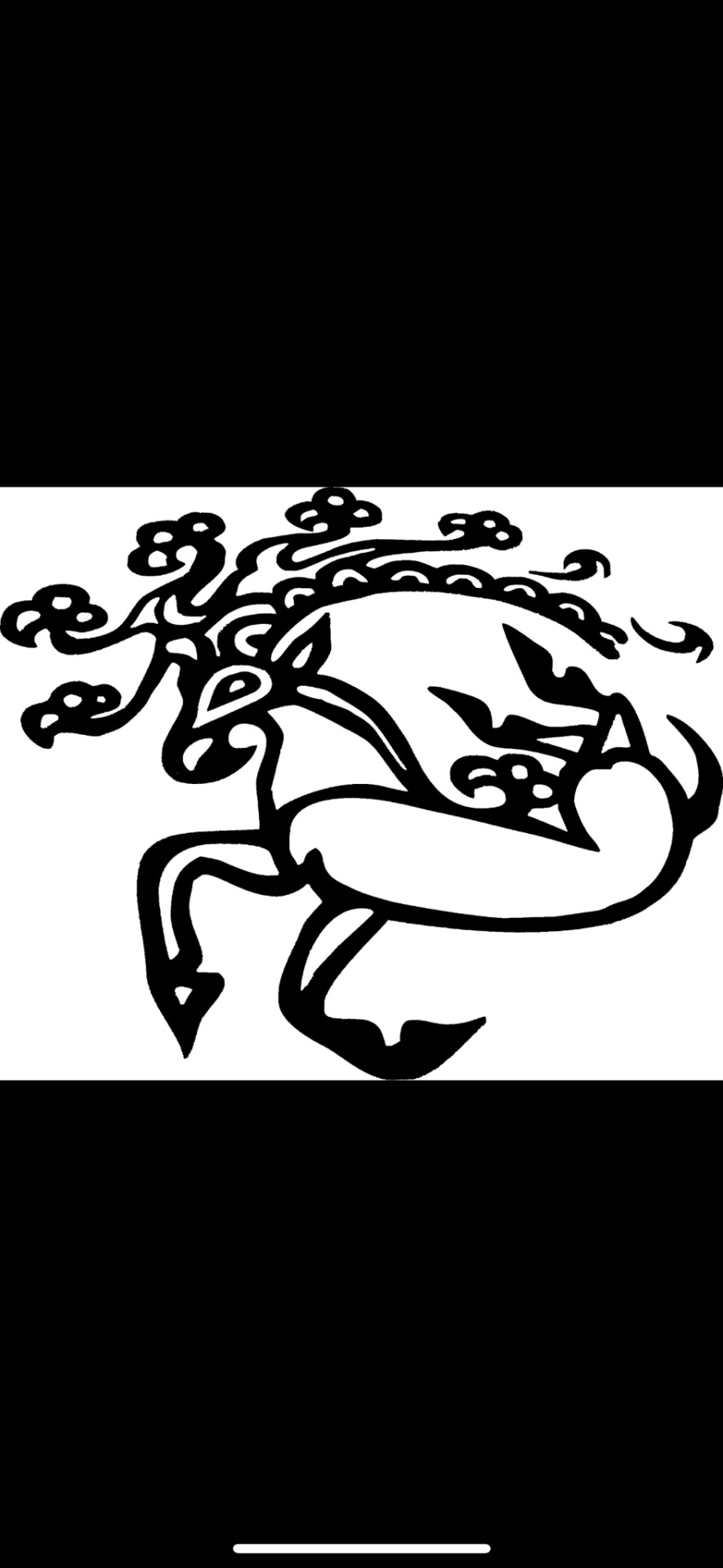

The Siberian Ice Maiden, known locally as the Princess of Ukok (Russian: Принце́сса Уко́ка), the Altai Princess (Russian: Алтайская принцесса), Devochka ("Girl") is a mummy of a woman from the 5th century BC, discovered in 1993 in a kurgan belonging to one of the Pazyryk burials, in the Republic of Altai, Russia.
She is famous for her tribal animal-style tattoos, which consist of creatures with horns that evolved into floral shapes. The local Altai people believe her to have supernatural powers and that the Ukok Plateau where she was found is the "second layer of heaven.”
Her head was shaved and she wore a wig and a tall hat, a long silk robe, a red wool skirt, and was 167cm tall. She was most likely a shaman or healer who had taken a vow of celibacy, as her body was used by her tribe in rituals up to three months after her death and she was determined to have inhaled cannabis vapor while alive.
She had been suffering from breast cancer that killed her in about three years, combined with injuries sustained in a fall.
She was buried with food such as horse meat, mutton, yogurt, coriander seeds and a beverage, which her tribe left her to sustain her on her journey to the afterlife. Her coffin was made of a larch wood tree trunk.
199 notes
·
View notes
Text
The Abasylar [Yakut mythology]!

In the indigenous religion of the Siberian Yakut people, there is an important distinction between the different spiritual worlds that are inhabited by supernatural beings. Among these beings, the Abasylar (singular: Abasy or also Abaasy) are a bit of an exception, because they inhabit both the lower and the upper world.
The Abasylar are evil, wicked spirits and are known to steal people’s souls. They are also horrifying to look at: an Abasy is a giant humanoid monster with a singular eye and seven huge teeth made of iron. This latter characteristic is because all creatures from the underworld have at least some iron body parts in Yakut belief. I noticed they are always depicted with one arm and one leg, but I don’t know the significance behind this.
Not entirely unlike humans, Abasylar form households and can own animals as cattle. People made animal sacrifices for them, in which horses were sacrificed to the Abasylar in the upper world, whereas those living in the lower world received horned cattle as offerings.

These creatures serve Arson Duolai (also called Ulu Tojon), the deity who presides over the dead. Interestingly, blacksmiths hold a special position in Yakut religion because their work directly links them to the spirits. They can hold a séance and make an offering to the god Kytai-Bakhsy, who is associated with smithing, for professional smithing skills and also divine protection.
This ritual involves the smith pulling the heart out of a dead calf and smashing it on an anvil with a forging hammer. From then on, their soul belongs to Kytai-Bakhsy, but both Abasylar and human shamans are then powerless against the smith. If an Abasy attempts to sneak up on the smith, Kytai-Bakhsy will intervene and grab the evil spirit with his tongs and hold it over the fire in the forge.
It is possible for a human shaman to ally themselves with an Abasy. Should they attempt to harm a smith under Kytai-Bakhsy’s protection, though, both of them will be punished. For some reason, this option doesn’t seem to exist for white smiths (who work with silver and copper, as opposed to a blacksmith’s iron).
Sources:
Znamenski, A. A., 2013, Shamanism in Siberia: Russian Records of Indigenous Spirituality, Springer Science and Business Media, 371 pp.
Jochelson, W., 2018, The Yakut, Kulturstiftung Sibirien, Verslag der SEC Publications, Bibliotheca Sibiro-pacifica, 256 pp., p. 106.
Coulter, C. R. and Turner, P., 2013, Encyclopedia of Ancient Deities, Routledge, 610 pp., p. 6.
(image source 1: Matt Gretton)
(image source 2: Deviantart user Skyggelys)
#Yakut mythology#Indigenous#Indigenous religion#Spirits#mythical creatures#mythology#folklore#world mythology#Giants
56 notes
·
View notes
Text



Amanita Muscaria 🍄🌀🍄 Talon Abraxas
The Fly Agaric mushroom (Amanita muscaria) has a long history in the shamanic traditions of Siberian, Tungusic, and Samoyedic cultures. This mushroom was not just used for its hallucinogenic properties but also as a spiritual conduit for accessing the unseen layers of reality.
Unlike typical psychedelic mushrooms, the Fly Agaric does not contain psilocybin but instead active compounds ibotenic acid and muscimol. These compounds interact with the body differently than those of traditional shrooms, yet they can still lead to altered states of consciousness and hallucinations. These altered states were essential for Siberian shamans, who used them to engage with the spirit world. The consumption of this mushroom was typically preceded by various ritualistic preparations such as fasting, isolation, and the wearing of ceremonial garments, believed to purify the shaman and enhance the mushroom’s spiritual effects. These mushrooms also have cultural significance, as they are woven into the folklore and traditions of these communities. For example, the Tungsic and Samoyed people hold the mushroom in high esteem and have folklore and mythologies rich with references to mushrooms. These cultures believed that mushrooms, especially the Fly Agaric, could act as mediators between the natural world and the spiritual realm, providing them with the ability to understand hidden wisdom, communicate with ancestral spirits, interpret dreams, and even see into the future. --The Spiritual Significance of Mushrooms in Ancient and Modern Cultures
82 notes
·
View notes
Text
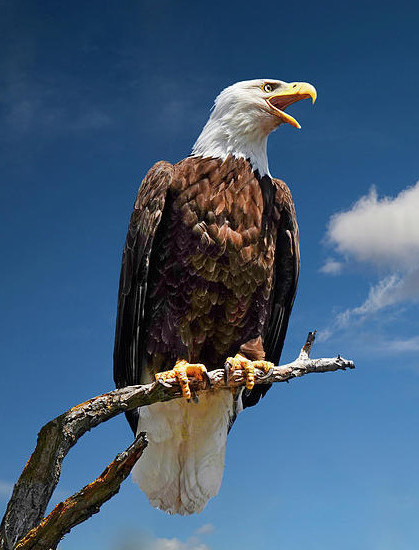
Legends and myths about trees
World tree - the source of wisdom of the ages
The world tree is a motif present in several religions and myths around the world. It is represented as a colossal tree which supports the heavens, thereby connecting the heavens, the terrestrial world, and, through its roots, the underworld.
Many Eurasian mythologies share the motif of the "world tree", "cosmic tree", or "Eagle and Serpent Tree". More specifically, it shows up in "Haitian, Finnish, Lithuanian, Hungarian, Indian, Chinese, Japanese, Norse, Siberian and northern Asian Shamanic folklore".
The World Tree is often identified with the Tree of Life, and also fulfills the role of an axis mundi, that is, a centre or axis of the world. It is also located at the center of the world and represents order and harmony of the cosmos. Each part of the tree corresponds to one of the three spheres of the world (treetops - heavens; trunk - middle world or earth; roots - underworld) and is also associated with a classical element (top part - fire; middle part - earth, soil, ground; bottom part - water).
Its branches are said to reach the skies and its roots to connect the human or earthly world with an underworld or subterranean realm. Because of this, the tree was worshipped as a mediator between Heavens and Earth. On the treetops are located the luminaries (stars) and heavenly bodies, along with an eagle's nest; several species of birds perch among its branches; humans and animals of every kind live under its branches, and near the root is the dwelling place of snakes and every sort of reptiles.
A bird perches atop its foliage, "often .... a winged mythical creature" that represents a heavenly realm. The eagle seems to be the most frequent bird, fulfilling the role of a creator or weather deity. Its antipode is a snake or serpentine creature that crawls between the tree roots, being a "symbol of the underworld".
The imagery of the World Tree is sometimes associated with conferring immortality, either by a fruit that grows on it or by a springsource located nearby. In some descriptions this "water of life" may also flow from the roots of the tree.
The world tree was an important element in shamanistic worldview as well, and it is said that the giant bird ... hatches shamans in the branches of the World Tree.
Some species of birds (eagle, raven, crane, loon, and lark) are revered as mediators between worlds and also connected to the imagery of the world tree. Another line of scholarship points to a "recurring theme" of the owl as the mediator to the upper realm, and its counterpart, the snake, as the mediator to the lower regions of the cosmos.
Northern Eurasian and Central Asian traditions wherein the World Tree is also associated with the horse and with deer antlers which might resemble tree branches.
Some scholars have pointed out that, from the perspective of evolutionary biology, the concept of a world tree may have originated in human thought. This is because our ancestors lived in trees for about 60 million years, and for them the trees were everything in the world. This is why the collective unconscious that the world is made of giant trees has remained with us to the present day.

木にまつわる伝説・神話
��界樹 〜 時代の叡智の源
世界樹は、世界中の宗教や神話に見られる概念、モチーフである。天を支える巨大な木として表現され、それによって天と地上世界、そしてその根を通して冥界をつないでいる。
多くのユーラシア神話が「世界樹」「宇宙樹」「鷲と蛇の樹」というモチーフを共有しているとされている。具体的には、「ハイチ、フィンランド、リトアニア、ハンガリー、インド、中国、日本、北欧、シベリア、北アジアのシャーマン伝承」に見られる。
世界樹はしばしば生命の樹と同一視され、また、世界軸、つまり世界の中心や軸の役割を果たす。また、世界の中心に位置し、宇宙の秩序と調和を表している。樹木の各部分は世界の3つの圏(梢-天、幹-中世界または地、根-地下世界)のいずれかに対応し、古典的な元素(上部-火、中部-地、土、地面、下部-水)にも関連している。
その枝は天空に届き、根は人間界や地上界と地下世界や地底界をつなぐと言われている。そのため、この木は天と地を結ぶ媒介として崇拝された。梢には星や天体があり、鷲の巣がある。枝には数種類の鳥がとまり、枝の下には人間やあらゆる動物が住み、根の近くには蛇やあらゆる爬虫類が住んでいる。
その葉の上にとまる鳥は、「しばしば......翼を持つ神話上の生き物」であり、天界を表す。鷲は最も頻繁に見られる鳥で、創造主や天候の神の役割を果たしているようだ。その対極にあるのは、木の根の間を這う蛇や蛇のような生き物で、「冥界の象徴」である。
世界樹のイメージは、そこに生る果実や近くにある泉によって不老不死をもたらすことと関連付けられることもある。この「生命の水」は木の根からも湧き出るという記述もある。
世界樹はシャーマニズムの世界観においても重要な要素であり、「巨大な鳥は......世界樹の枝でシャーマンを孵化させる」ともいわれている。
いくつかの種の鳥(ワシ、ワタリガラス、ツル、ハシビロコウ、ヒバリ)は、世界をつなぐ媒介者として崇められ、世界樹のイメージとも結��ついている。また、別の研究では、フクロウは天上界への媒介者であり、それと対をなすヘビは宇宙の下界への媒介者であるという「繰り返されるテーマ」が指摘されている。北ユーラシアや中央アジアの伝統では、世界樹は馬や、木の枝に似た��の角とも関連づけられている。
一部の学者は、進化生物学の観点から、世界樹という概念が人類の思考の中に元から備わっている可能性を指摘している。というのも、人類の祖先は約6000万年にわたり樹上で生活しており、その時代の彼らにとっては木々こそが世界のすべてであったと考えられるからである。そのため、この世界は巨大な木で出来ているのだという集合的無意識が、現在の我々に至るまで残っているのだというものである。
#trees#tree legend#tree myths#legend#mythology#folklore#world tree#bird#tree of life#water of life#sharamanism#nature#art#source of wisdom
147 notes
·
View notes
